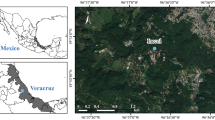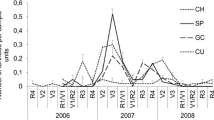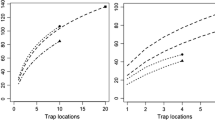Summary
The relative importance of phylogenetic affinity of hosts versus their ecological characteristics in determining the composition of their parasitoid complexes was examined using the parasitoid complexes of six species of frugivorous fruit flies from Central Europe. The hosts were four Rhagoletis and two other trypetine species, ranging in their relatedness from host races to members of different genera. They also differed in ecological characteristics, utilizing host plants of three different families, and developing either as pulp- or seedfeeders inside the host fruit. These features made it feasible to test the following pair of hypotheses. The ecological hypothesis predicts that ecological traits such as host-plant and fruit fly phenologies and host-fruit texture should be more important for the composition of parasitoid complexes than the taxonomic relatedness of the fly species. Assuming that ecological relationships do not parallel phylogenetic ones, the alternative phylogenetic hypothesis predicts the opposite. In fruit and soil samples, taken between 1983 and 1989, three guilds of parasitoids comprising 20 species were found: guild 1 — koinobiotic larval parasitoids (e.g. Opius spp., which attack the host larvae but develop inside the host puparia); guild 2 — idiobiotic larval parasitoids (e.g. Pteromalus spp., which consume the host larvae at once); and guild 3 — idiobiotic puparium parasitoids (e.g. Phygadeuon spp.). Although some results support the phylogenetic hypothesis, the majority of results support the ecological hypothesis.
Similar content being viewed by others
References
Askew RR, Shaw MR (1986) Parasitoid communities: their size, structure and development. In: Waage J, Greathead D (eds) Insect parasitoids. Academic Press, London, pp 225–264
Berlocher SH, Bush GL (1982) An electrophoretic analysis of Rhagoletis (Diptera: Tephritidae) phylogeny. Syst Zool 31:136–155
Boller E, Bush GL (1974) Evidence for genetic variation in populations of the European cherry fruit fly, Rhagoletis cerasi (Diptera: Tephritidae) based on physiological parameters and hybridization experiments. Entomol Exp Appl 17:279–293
Bush GL (1966) The taxonomy, cytology, and evolution of the genus Rhagoletis in North America. Bull Mus Comp Zool 134:431–562
Dogiel VA (1963) Allgemeine Parasitologie. In: Eichler W, Sprehn CEW, Stammer HJ (eds) Parasitologische Schriftenreihe 16, Gustav Fischer, Jena
Fischer M (1973) Hymenoptera Braconidae (Opiinae I). In: Mertens R, Hennig W (eds) Das Tierreich, Lieferung 91. Walter de Gruyter, Berlin
Fitt GP (1986) The roles of adult and larval specialisations in limiting the occurrence of five species of Dacus (Diptera: Tephritidae) in cultivated fruits. Oecologia 69:101–109
Gibson GAP (1990) Revision of the genus Macroneura Walker in America north of Mexico (Hymenoptera: Eupelmidae). Can Entomol 122:837–873
Harvey PH, Pagel MD (1991) The comparative method in evolutionary biology. Oxford University Press, Oxford
Hawkins BA (1988) Species diversity in the third and fourth trophic levels: patterns and mechanisms. J Anim Ecol 57:137–162
Hawkins BA (1990a) Global patterns of parasitoid assemblage size. J Anim Ecol 59:57–72
Hawkins BA (1990b) Do galls protect endophytic herbivores from parasitoids? A comparison of galling and non-galling Diptera. Ecol Entomol 13:473–477
Hawkins BA, Gagne RJ (1989) Determinants of assemblage size for the parasitoids of Cecidomyiidae (Diptera). Oecologia 81:75–88
Hawkins BA, Askew RR, Shaw MR (1990) Influences of host feeding-niche and foodplant type on generalist and specialist parasitoids. Ecol Entomol 15:275–280
Herting B (1971–1982) A catalogue of parasites and predators of terrestrial arthropods. Section A, Vol. 1–6, Section B, Vol. 2. CAB Commonw Inst Biol Control
Hoffmeister T (1990) Zur Struktur und Dynamik des Parasitoidenkomplexes der Kirschfruchtfliege Rhagoletis cerasi L. (Diptera: Tephritidae) auf Kirschen und Heckenkirschen. Mitt Dtsch Ges Allg Angew Entomol 7:546–551
Jeffries MJ, Lawton JH (1984) Enemy free space and the structure of ecological communities. Biol J Linn Soc 23:269–286
Mackauer M (1967) Wirtsbindung und parallele Evolution parasitischer Hymenopteren. I. Allgemeines und Parasiten der Homopteren, 1. Teil. Angew Parasitol 8:21–39
Morris KRS (1938) Eupelmella vesicularis Retz. (Chalcididae) as a predator of another chalcid, Microplectron fuscipennis Zett. Parasitology 30:20–32
Mühlenberg M (1989) Freilandökologie. 2nd edn. Quelle & Meyer, Heidelberg
Price PW (1980) Evolutionary biology of parasites. Princeton University Press, Princeton
Price PW, Pschorn-Walcher H (1988) Are galling insects better protected against parasitoids than exposed feeders?: a test using tenthredinid sawflies. Ecol Entomol 13:195–205
Pschorn-Walcher H (1957) Probleme der Wirtswahl parasitischer Insekten. Ber 8. Wandervers deutsch Entomol (München 1957) 79–85
Pschorn-Walcher H (1965) Die Wirtsspezifität der parasitischen Hymenopteren in ökologisch-phylogenetischer Betrachtung (unter besonderer Berücksichtigung der Blattwespenparasiten). Ber 10. Wandervers deutsch Entomol (Dresden 1965) 55–63
Pschorn-Walcher H (1985) Konkurrenz und Mannigfaltigkeit bei Parasitoiden. Z Zool Syst Evolut-forsch 23:286–298
Pschorn-Walcher H, Altenhofer E (1989) The parasitoid community of leaf-mining sawflies (Fenusini and Heterarthrini): a comparative analysis. Zool Anz 222:37–56
Strong DR (1984) Exorcising the ghost of competition past: phytophagous insects. In: Strong DR, Simberloff D, Abele LG, Thistle AB (eds) Ecological communities: conceptual issues and the evidence. Princeton University Press, Princeton, pp 28–41
Strong DR, Lawton JH, Southwood R (1984) Insects on plants: Community patterns and mechanisms. Blackwell, Oxford
Takhtajan AL (1980) Outline of the classification of flowering plants (Magnoliophyta). Bot Rev 46:225–349
van Alphen JJM, Vet LEM (1986) An evolutionary approach to host finding and selection. In: Waage J, Greathead D (eds) Insect parasitoids. Academic Press, London, pp 23–61
van Driesche RG (1983) Meaning of “percent parasitism” in studies of insect parasitoids. Environ Entomol 12:1611–1622
Vinson SB (1976) Host selection by insect parasitoids. Annu Rev Entomol 21:109–133
Zwölfer H (1963) Untersuchungen über die Struktur von Parasitenkomplexen bei einigen Lepidopteren. Z Angew Entomol 51:346–357
Zwölfer H (1971) The structure and effect of parasite complexes attacking phytophagous host insects. In: den Boer PJ, Gradwell GR (eds) Dynamics of populations. Centre for agricultural publishing and documentation, Wageningen, pp 405–418
Zwölfer H (1983) Life systems and strategies of resource exploitation in tephritids. Proc CEC/IOBC Int Symp Athens, Greece, 16–19 November 1982. In: Cavalloro R (ed) Fruit flies of economic importance. AA Balkema, Rotterdam, pp 16–30
Zwölfer H (1987) Species richness, species packing, and evolution in insect-plant systems. Ecol Stud 61:301–319
Zwölfer H, Herbst J (1988) Präadaptation, Wirtskreiserweiterung und Parallel-Cladogenese in der Evolution von phytophagen Insekten. Z Zool Syst Evolutionsforsch 26:320–340
Author information
Authors and Affiliations
Rights and permissions
About this article
Cite this article
Hoffmeister, T. Factors determining the structure and diversity of parasitoid complexes in tephritid fruit flies. Oecologia 89, 288–297 (1992). https://doi.org/10.1007/BF00317230
Received:
Accepted:
Issue Date:
DOI: https://doi.org/10.1007/BF00317230




